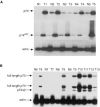E7 proteins from oncogenic human papillomavirus types transactivate p73: role in cervical intraepithelial neoplasia
- PMID: 11870517
- PMCID: PMC2375198
- DOI: 10.1038/sj.bjc.6600033
E7 proteins from oncogenic human papillomavirus types transactivate p73: role in cervical intraepithelial neoplasia
Abstract
In common with other E2F1 responsive genes such as p14(ARF) and B-myb, the promoter of p73 is shown to be positively regulated in cell lines and primary human keratinocytes by E7 proteins from oncogenic human papillomavirus (HPV) types 16, 18, 31 and 33, but not HPV 6. Mutational analysis revealed that transactivation of the p73 promoter by HPV 16E7 requires association with pRb. Expression of p73 in normal cervical epithelium is confined to the basal and supra-basal layers. In contrast, expression in neoplastic lesions is detected throughout the epithelium and increases with grade of neoplasia, being maximal in squamous cell cancers (SCC). Deregulation of expression of the N-terminal splice variant p73Delta2 was observed in a significant proportion of cancers, but not in normal epithelium. The frequent over-expression of p73Delta2, which has recognized transdominant properties, in malignant and pre-malignant lesions suggests a role in the oncogenic process in cervical epithelium.
Copyright 2002 The Cancer Research Campaign
Figures




Similar articles
-
p73 is over-expressed in vulval cancer principally as the Delta 2 isoform.Br J Cancer. 2001 Nov 16;85(10):1551-6. doi: 10.1054/bjoc.2001.2138. Br J Cancer. 2001. PMID: 11720444 Free PMC article.
-
High level HPV-16 E7 oncoprotein expression correlates with reduced pRb-levels in cervical biopsies.FASEB J. 2004 Jul;18(10):1120-2. doi: 10.1096/fj.03-1332fje. Epub 2004 May 20. FASEB J. 2004. PMID: 15155561
-
DNA aneuploidy and integration of human papillomavirus type 16 e6/e7 oncogenes in intraepithelial neoplasia and invasive squamous cell carcinoma of the cervix uteri.Clin Cancer Res. 2004 May 1;10(9):3059-63. doi: 10.1158/1078-0432.ccr-03-0565. Clin Cancer Res. 2004. PMID: 15131043
-
[Cellular and molecular pathogenesis of cancer of the cervix].Contracept Fertil Sex. 1995 Dec;23(12):731-40. Contracept Fertil Sex. 1995. PMID: 8556072 Review. French.
-
[Epidemiology of cervical papillomavirus infections. Recent knowledge].Presse Med. 2001 Jun 9;30(20):1017-23. Presse Med. 2001. PMID: 11433694 Review. French.
Cited by
-
Aberrant cell cycle regulation in cervical carcinoma.Yonsei Med J. 2005 Oct 31;46(5):597-613. doi: 10.3349/ymj.2005.46.5.597. Yonsei Med J. 2005. PMID: 16259056 Free PMC article. Review.
-
Up regulation in gene expression of chromatin remodelling factors in cervical intraepithelial neoplasia.BMC Genomics. 2008 Feb 4;9:64. doi: 10.1186/1471-2164-9-64. BMC Genomics. 2008. PMID: 18248679 Free PMC article.
-
Loss of E2F1 Extends Survival and Accelerates Oral Tumor Growth in HPV-Positive Mice.Cancers (Basel). 2015 Dec 8;7(4):2372-85. doi: 10.3390/cancers7040895. Cancers (Basel). 2015. PMID: 26670255 Free PMC article.
-
Cellular transformation by human papillomaviruses: lessons learned by comparing high- and low-risk viruses.Virology. 2012 Mar 15;424(2):77-98. doi: 10.1016/j.virol.2011.12.018. Epub 2012 Jan 27. Virology. 2012. PMID: 22284986 Free PMC article. Review.
-
The papillomavirus E7 proteins.Virology. 2013 Oct;445(1-2):138-68. doi: 10.1016/j.virol.2013.04.013. Epub 2013 May 31. Virology. 2013. PMID: 23731972 Free PMC article. Review.
References
-
- BatesSPhillipsACClarkePAStottFPetersGLudwigRLVousdenKH1998p14ARF links the tumour suppressors RB and p53 Nature 395124125 - PubMed
-
- ChiS-GChangS-GLeeS-JLeeC-HKimJIParkJ-H1999Elevated and biallelic expression of p73 is associated with progression of human bladder cancer Cancer Res 5927912793 - PubMed
-
- CornPGKuerbitzSJvan NoeselMMEstellerMCompitelloNBaylinSBHermanJG1999Transcriptional silencing of the p73 gene in acute lymphoblastic leukemia and Burkitt's lymphoma is associated with 5′CpG methylation Cancer Res 5933523356 - PubMed
-
- De LaurenziVRossiATerrinoniABarcoroliDLevreroMCostanzoAKnightRAGuerrieriPMelinoG2000p63 and p73 transactivate differentiation gene promoters in human keratinocytes Biochem Biophys Res Commun 273342346 - PubMed
MeSH terms
Substances
LinkOut - more resources
Full Text Sources
Other Literature Sources
Medical
Molecular Biology Databases
Research Materials

